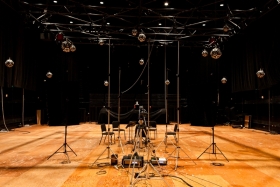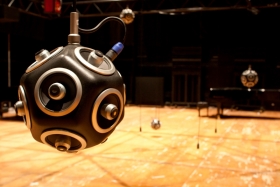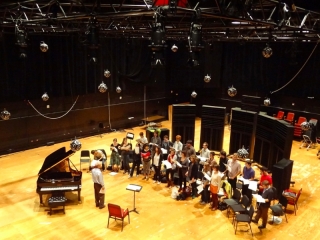McGill’s Virtual Acoustics Technology (VAT) offers new solutions in the key areas of room acoustics serving musical performance by focusing on the electro-acoustic coupling between existing room acoustics and simulation acoustics.
Background
An innovative electro-acoustic enhancement system, based on measured high-resolution impulse responses, is currently in development at the Virtual Acoustic Technology (VAT) Lab of McGill University. Since 2005, the research team at VAT Lab has measured high-resolution room impulse responses of various acoustic spaces in three dimensions. Sound sources used for the measurements consisted of 2 sub-woofers, 2 super-tweeters and dipole, monopole and omni types of speakers. Between 8 and 14 loudspeakers were placed in a room to generate slow logarithmic sine sweeps radiated in multiple directions. The acoustic responses of rooms were then captured with an 8-channel surround microphone configuration, in width, depth, and height dimensions with 2 height channels at 32bit/96kHz resolution. The virtual acoustic response is created using a low-latency convolution engine and a three-way temporal segmentation of the measured impulse responses.
Development
The first model of VAT was installed in the Multi-Media Room (MMR) at McGill University’s Schulich School of Music, a large rectangular space (80ft x 60ft x 50ft) designed as a film scoring stage. The system used an array of 16 omni-directional radiators within the room, suspended from a motorized grid and spaced in three dimensions. Its signal processing included 24-channel low-latency convolution at 24bit/96KHz, three separate stages of matrix mixing, equalization and time variation. The system of 192 loudspeakers, clustered into 16 low diffraction dodecahedron spheres, renders a homogeneous ambient sound with flat diffuse field response. A lift-equipped grid allows all loudspeakers to be brought up or down to accommodate each type of ensemble, and thereby best enhance the auditory presence of the virtual acoustics. All control parameters of the active acoustics are implemented in ‘Space Builder’, a multi-channel sound design engine, by employing multichannel parallel mixing, routing, and processing. The current generation VAT system provides the following key features:
- Uniform distribution of sound energy within the hall in a wide frequency range
- Minimized system delay providing immediate acoustic response to the musicians
- Ability to individually control direct, early reflections (ER), mid and late reverberation
- Ability to provide direct, ER, mid and late reverberation to any location in the hall
- System stability with low risk of feedback and minimal sound coloration
Evaluation
Field tests are currently underway at McGill University involving performing musicians and ensembles in order to fully assess and quantify the benefits of this new approach in active acoustics. Musicians receive acoustic support from room models stored in our library of measured architectural spaces. During performance in virtual acoustics, musicians can blend in desired components of room responses in order to improve their own interaction with the room acoustics and with other players.
Using objective measurements of the system, we adjust parameters to improve on-stage acoustics and then verify the enhancement perceptually. Parameters such as inter-aural cross correlation coefficient (IACC), clarity C80, early stage support (ST1), and early decay time (EDT) are monitored while virtual rooms are created without excessively increasing the overall acoustic energy in the room. These parameters are responsible for controling subjective aspects of clarity, reverberance and immersion. The subjective evaluations are collected from multiple recording sessions with professional musicians using the system. They show that musicians uniformly agree on the best settings providing the enhanced acoustic conditions for a particular performance. Choral ensembles, soloists, jazz and string quartets are able to “play the room”, and they find virtual acoustics to be a helpful and enjoyable means for enhancing their musical performance.
The new phase
Since 2017, the Multimedia Room has been undergoing a major renovation funded by the CFI (Canada Foundation for Innovation) and was therefore unavailable to all research and academic activities. The VAT Lab infrastructure is being moved to the Immersive Media Lab, a recording studio space next door in the Elizabeth Wirth Music Building. The new software-based VAT system becomes a permanent component of the studio, which will be opened in the first quarter of 2021. The VAT will also be used in the renovated space of the MMR as a portable component, once the MMR is completed and opened for research in 2021.



